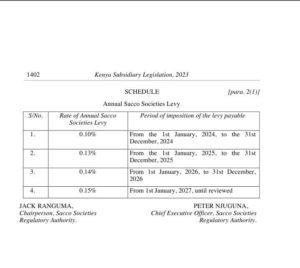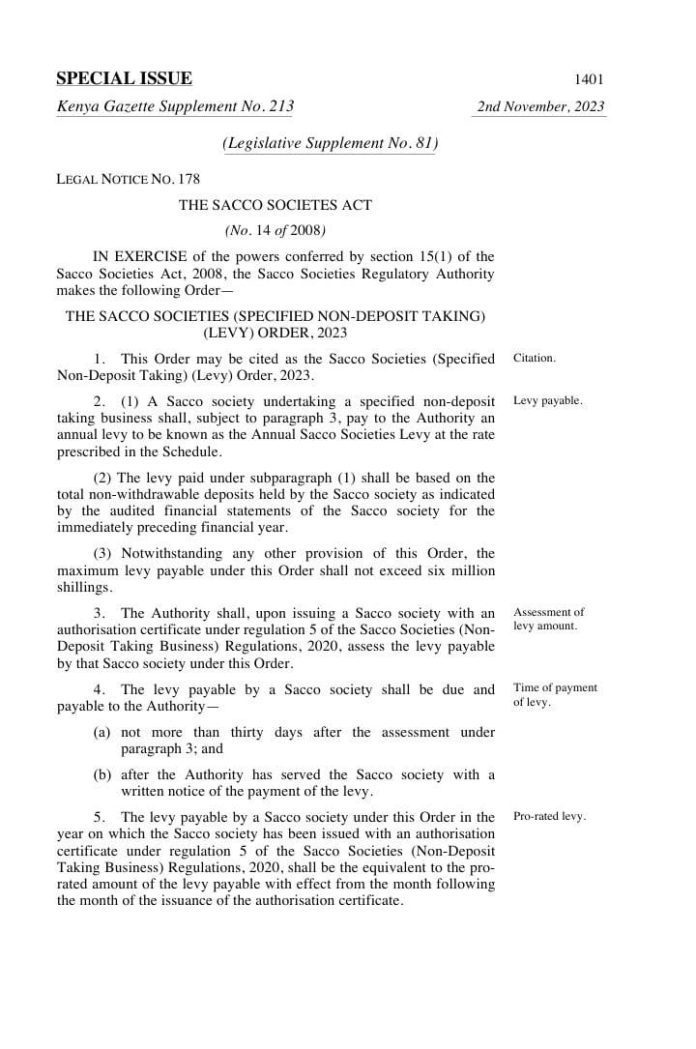The Sacco Societies Regulatory Authority (SASRA) has introduced a levy on Non-Withdrawable Deposit-Taking Saccos, beginning January 2024, as the regulator seeks to wean itself from the exchequer, widen its funding base and increase its surveillance footprint.
This levy is the tax charged on cash deposits held by DT Saccos. At present, all the 175 DT Sacco pay a Sacco Deposit levy of 1.75%.
According to a notice from SASRA, it has introduced this same levy, set at 0.10 percent of the non-withdrawable deposits between January 1 and December 31, 2024, rising to 0.13 percent in 2025, 0.14 percent in 2026, and 0.15 percent in 2027.
These new levy rates are a change from an initial proposal by SASRA to charge a levy of 0.165% on the total non-withdrawable deposits of the targeted Saccos.
This levy will be paid based on the total non-withdrawable deposits held by a DT Sacco as indicated by the audited financial statements of the Sacco Society for the immediately preceding financial year.
SASRA is introducing these new levies after preparing a Regulatory Impact Statement (RIS) to assess the impact of the Levy Order on the Non-Withdrawable Deposit-Taking SACCOs (Non-WDT-SACCOs) and their members.
The Sacco Act 2020 regulations expanded the regulatory mandate of SASRA, giving the regulator new revenue streams and supervisory mandate over non-withdrawable DT Saccos with deposits of more than Ksh 100 Million.
According to available data, SASRA has more than 190 out of an estimated 360 non-withdrawable deposit-taking Saccos, under its regulatory watch.
SASRA intends to move from supervising 175 deposit-taking Saccos to 360 Sacco. The framing of the new regulations is such that every month there is a Sacco whose deposits are reaching Ksh 100 Million and automatically come under SASRA’s supervisory regime.
When SASRA was established more than 12 years ago, it did not benefit from exchequer seed capital and has thus be relying on levies and fees that it charges on Deposit-Taking Saccos. It has thus expanded its revenue base by targeting non-withdrawable deposit-taking Saccos.
This new levy affects any Sacco with funds of more than Ksh 100 Million.


In its initial proposal, SASRA said the levy is restricted to a maximum of Ksh 8 Million meaning that Saccos holding deposits of less than Ksh 4.84 Billion were to be spared this expense. In the new arrangement, the maximum levy payable by the NWDT Saccos is limited to not more than Ksh 6 million.
All the 175 Deposit-Taking Saccos that run FOSAs already pay a levy to SASRA which has in the past increased the fee from 0.1 percent to 0.125 percent and then to the current 0.175 percent. Efforts to increase this fee for DT Saccos have since met stiff resistance from the industry players.
The levy is paid based on deposits held in any Deposit-Taking Sacco Society that operates a FOSA, at the rate of 0.175 percent of the Total Deposits as indicated in the last audited financial statements, subject to a maximum of Ksh 10 million per annum.
This is according to The Sacco Societies Levy Order, 2016.
The decision by SASRA to charge a levy on Saccos engaged in non-withdrawable deposit-taking business is informed by dwindling financial support from the Exchequer to fund its budget and operations.
SASRA argues that it needs to charge the levy to finance the budget deficit which has widened with dwindling financial support from the National Treasury.
The regulator says it needs to build the capacity of the technical staff to benchmark with the rest of the world. DT Saccos have been growing fast, some exceeding the size of some mid-sized commercial banks, meaning that these financial outfits face high-risk exposure to deposits held on behalf of members.
Non-withdrawable deposits held by a Sacco is the share capital paid by a member that cannot be withdrawn or reduced.
Available data indicates that non-withdrawable deposit-taking (NWDT) savings reached KSh97.86 billion by the end of June 2023 from KSh 90.64 billion over a similar period in 2022.
SASRA is targeting to raise at least an extra KSh100 million annually through its new levy.
Available data shows that the cash-strapped SASRA had its deficit widen by 49.8% to Ksh 32.8 Million in 2022 from a deficit of Ksh 21.9 million in 2021 according to audited figures from its latest published results for the financial year ended 30th June 2022.
SASRA is the regulatory body that issues permits to Deposit‑Taking Sacco Societies as well as those Saccos involved in specified non-deposit-taking businesses in Kenya.
The Sacco Sub-Sector Regulator took the biggest hit on its books from Depreciation and Amortization Expenses, which increased from Ksh 69.2 Million in 2021 to Ksh 111.7 Million in 2022.
SASRA, however, increased revenues from levies charged on Sacco businesses, from Ksh 420.9 million in 2021 to Ksh 495.2 million in 2022 while earnings from licenses, fees, and permits increased from Ksh 17.4 million in 2021 to Ksh 36.9 million in 2022.
The Authority recorded an increase in license fees and permits as new regulations came into play, bringing in large non-withdrawable DT Saccos with deposits of more than Ksh 100 million under its supervision. This is in addition to the 175 DT Saccos that are also regulated by SASRA.
According to the Authority’s statement of financial position as of 30th June 2022, its balance sheet size grew from KSh 440.1 million in 2021 to KSh 564.7 million in 2022.
Total reserves and funds increased from KSh 440.1 million to KSh 564.7 million in 2022. The Authority saw its accumulated deficit widen from KSh 250.2 million in 2021 to KSh 275.6 million in 2022.
SASRA recorded a bigger deficit in 2022 at a time when its supervisory capabilities are under strain following the widening of its oversight to include Non-Deposit-Taking Savings and Credit Co-operative Societies (BOSAs) with deposits of more than Ksh 100 million.
According to the list of authorized Saccos to undertake deposit-taking business in Kenya in 2023, some 176 Deposit-Taking Saccos were licensed while 183 Saccos received specified non-deposit-taking business authorization from SASRA. These Back Office Service Activity (BOSA) Saccos were previously supervised by the Office of Commissioner for Co-operative Development.
With reduced financial support from the exchequer, experts have questioned the ability of SASRA to monitor and sanction non-compliant Saccos.
The new 0.10percent levy rate on NWDT Saccos set for the period January 1 to December 31, 2024, will translate to an extra KSh97.86million revenue toward SASRA operations when calculated against the KSh97.86 billion NWDT deposits for the period that ended June 2023.





